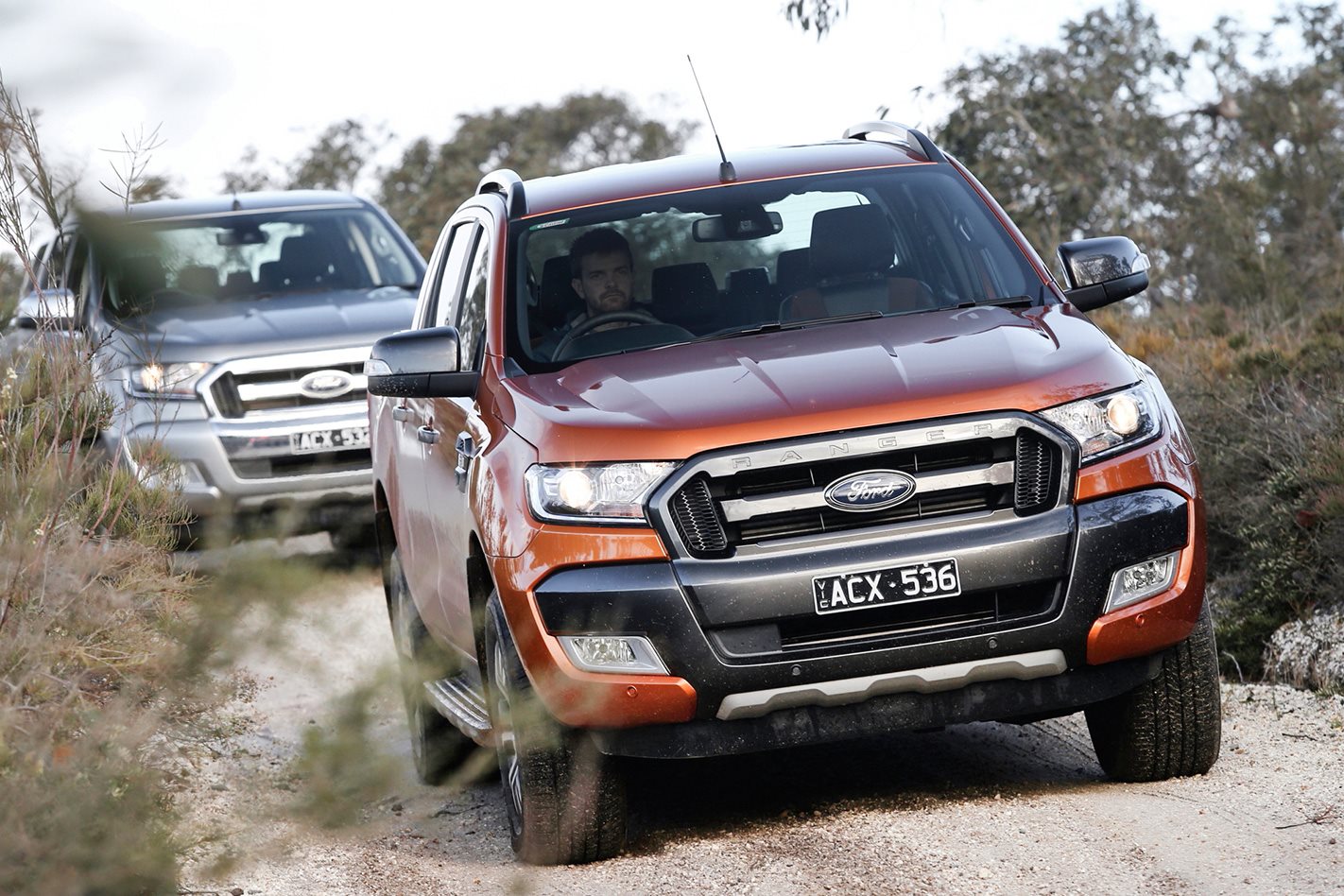Wheels review
Ford has refreshed its popular Ranger ute for 2016, with styling and tech upgrades aimed at making upper-spec XLT and Wildtrak double cabs more attractive for families.
WHAT IS IT Ford’s five-tier Ranger line up has taken the showroom fight to the Toyota Hilux, and it punches on in 2016 with class-leading safety tech.
WHY WE’RE TESTING IT Ford is first to bring safety features like lane departure warning, collision warning and radar cruise control to the light truck segment, and this becomes more important as these vehicles get more popular with family buyers and recreational off-road enthusiasts.
MAIN RIVALS Toyota Hilux; Mazda BT-50; Mitsubishi Triton; Volkswagen Amarok; Nissan Navara.
THE WHEELS VERDICT Ranger has always been a class leader for size, capacity, ability and performance. Now it leads the truck pack again with renewed safety features. But it also leads them on price: the top-spec Wildtrak is one of the most expensive utes of its type.
PLUS: Safety tech; performance; more refined MINUS: Massive size; not so refined down the range; rear camera only on top model
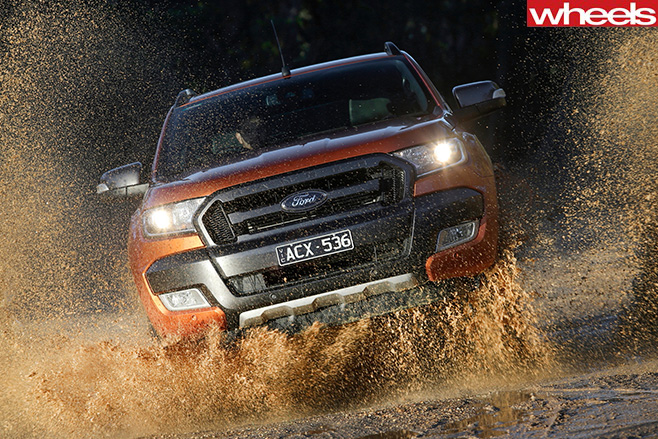
A key part of the new PXII Ranger line is a Tech Pack that is optional on the upper spec XLT and Wildtrak variants. The pack includes adaptive cruise control with collision alert; lane departure warning with lane keep assist; a driver impairment monitor that keeps tabs on the driver’s actions and gives a warning if the car thinks the driver is tiring; and a reversing camera which is standard on Wildtrak.
While it’s good news that these features are filtering though to light trucks from passenger cars, not so good here is that the reversing camera is only optional on the Ranger XLT and not available at all for the lower grades. However, rear park assist is standard on XLT and on the Wildtrak, which also gets front parking sensors.
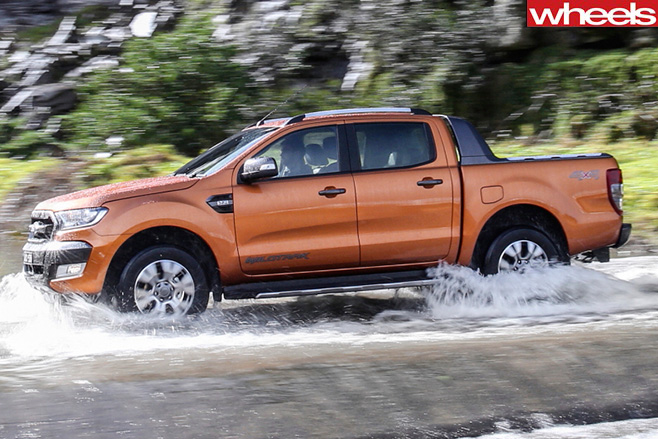
The exterior styling upgrades are limited to the metal forward of the A-pillar, with new ’guards and bonnet and a more contemporary front fascia. The interior cops a more comprehensive makeover. The piddly little dash screen of the previous generation has been replaced in XLT and Wildtrak Rangers with an 8.0-inch touch screen featuring Ford’s SYNC2 interface, while the XL and XLS variants get a smaller 4.2-inch screen with SYNC1 which is still way better than the old one. XLT and Wildtrak also get a new gauge cluster featuring dual customisable screens either side of the digital speedometer, while the lesser grades feature a more basic dash.
Mechanically speaking, the Ranger carries over its two diesel engines: the 118kW/385NM 2.2-liter four cylinder and more popular 147kW/470Nm 3.2-liter five-pot. Both of these turbocharged engines offer adequate performance when the trucks are unladen, but if you want to test the one-tonne payload or 3.5-tonne towing capacity you really want to opt for the bigger more powerful mill.
Neither engine makes the Ranger a rocketship but the 3.2 is the stronger performer. The 3.2 also benefits from improvements to the fuel injection system for 2016 which have made the engine quieter. The 2.2 remains a bit noisy and harsh when on the throttle and will find favour only with fleet buyers.
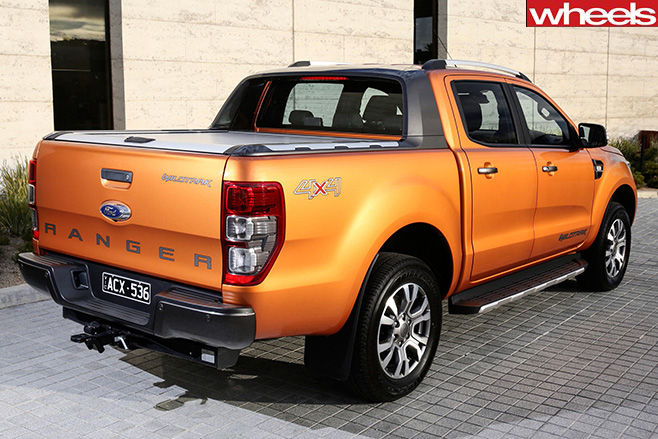
Buyers of the Ranger shouldn’t expect sports-car like gear shifting regardless. These are light trucks and there is nothing sporty about them. They are big, heavy and a chore to park in the city environment. This is why rear cameras would be such a benefit to drivers. Despite the overall size, the space in the rear seat can’t match that of a 4×4 wagon or a traditional station wagon, and nor are they as comfortable. But then you can’t toss a tonne of whatever into the back of those wagons.
The Ranger feels more at home out on open roads and bush tracks, where visibility from behind the wheel is good and the seating position okay despite there being no reach adjustment on the steering column. The new electrically assisted power steering is super light at parking speeds but firms up out on the road, while the suspension soaks up bumps and potholes well. Ford claims the suspension is the same across the range but we felt that the Wildtrak had a softer, more compliant and passenger-friendly calibration.
The Wildtrak also benefits from the most sound insulation, and disappointingly this dwindles down the range. We would expect that at least the XLT models would get the top level of insulation, for buyers who don’t want the flashy features of the Wildtrak yet still expect a high level of refinement with their $60K truck.
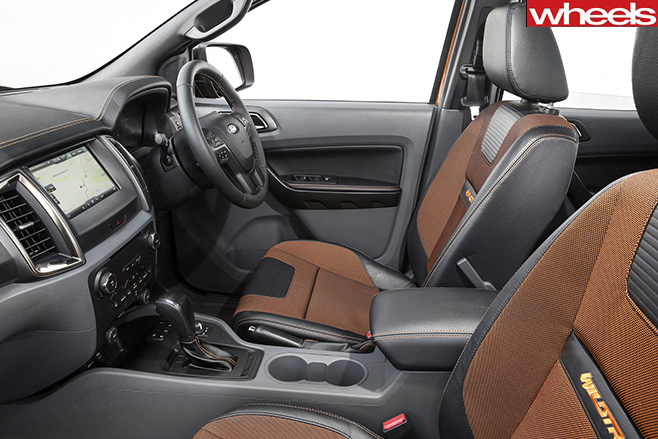
Ranger 4×4 remains a competent performer off road. A full complement of electronic driver aids help its cause, and standard features include low range gearing in the transfer case, a lockable rear differential (also usefully included on 4×2 Hi-Rider models) and adjustable electronic hill descent control. The 800mm wading depth is another class-leading feature of Ranger.
With more buyers in the market for utes, and more utes coming to market, this segment will continue to boom through the latter part of 2015 and into the new year. Ford hopes to spearhead the charge with its extensive line up of Rangers.
NOT SO LONE RANGER
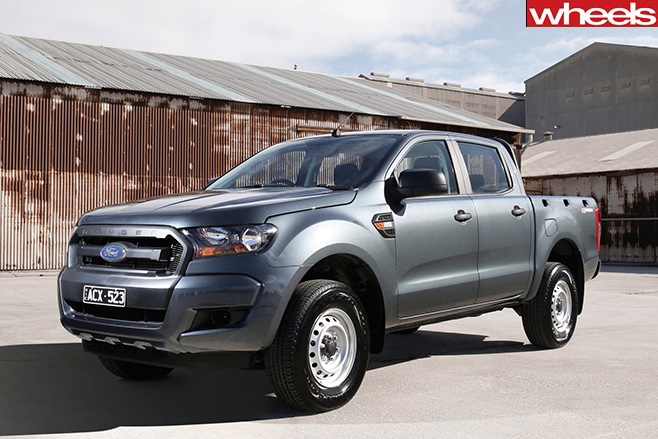
The XL-Plus models, specced for mining and industry fleet buyers, have been carried over to the PXII range. Available only as 4×4 with 3.2 engine and auto trans, and as single cab-chassis, double cab-chassis or double-cab ute, the XL-plus has all the basic features of the XL but also an extended wiring harness for additional lighting and an extra four-switch panel, an auxiliary battery, and 17-inch steel wheels with all-terrain tyres. Daytime running lights and plastic side steps are also part of the XL-Plus package.
SPECS Model: 2016 Ford Ranger Wildtrak PXII Engine: 3.2L turbo-diesel Max power: 147kW @ 3200rpm Max torque: 470Nm @ 1750rpm Transmission: 6-speed automatic Weight: 2200kg Fuel economy: 9.0L/100km Price: $60,090
Click here to read the full range review of the Ford Ranger
Second opinion: 4×4 Australia’s verdict
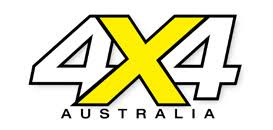
4X4: Australia’s guide to the off-road adventure lifestyle.
Mixing in-depth vehicle reviews with off-the-beaten-track adventures and gear tests, 4X4 is all about enjoying Australia’s great outdoors.
Ford has refreshed its popular Ranger ute with new style and tech for 2016

Double-cab, one-tonne 4×4 utes continue to grow in popularity as family vehicles.
With a swag of new and upgraded models hitting showrooms in the second half of 2015, the numbers of them on suburban streets, worksites and bush tracks will only increase.
Ford has counter-punched the all-new models launched by Mitsubishi (Triton) and Nissan (Navara), and taken a pre-emptive strike on the soon-to-be released 2016 Toyota Hilux, with a major makeover of its Ranger truck introducing first-in-class technologies, improved refinement and refreshed styling.
A key part of the PXII Ranger line-up is a ‘Tech Pack’ that is optional on the upper-spec XLT and Wildtrak variants. The pack includes adaptive cruise control with collision alert; lane departure warning with lane keep assist; a driver impairment monitor that keeps tabs on the driver’s actions and gives a warning if the car thinks the driver is tiring; and a reversing camera which is standard on Wildtrak but only optional on the XLT.
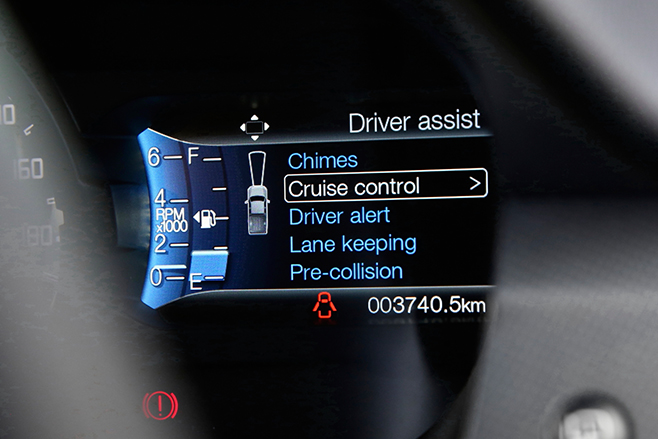
While it’s good news that these features are filtering through from passenger cars to light trucks. Not so good here is that the reversing camera is only optional on XLT and not available at all for the lower grades.
Rear park assist is standard on XLT and Wildtrak, which also receives front parking sensors. Adaptive cruise and collision warnings and lane assist are first-in-class technologies in the Ranger. But it is believed that some of these features will be included in the new Toyota Hilux to be introduced in October, making this style of vehicle more appealing to family buyers.
Like most of the modern one-tonners, the Ranger has a five-star ANCAP safety rating. Putting aside the tech stuff, the Ranger retains its solid, body-on-frame chassis and suspension with a revised calibration to improve ride. The 4×4 system remains part-time with a rear locker fitted across the range of 4×4 and even some of the 4×2 models.
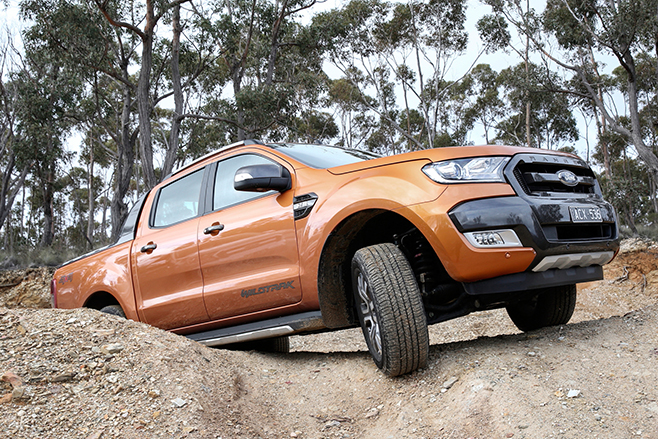
The two diesel engines are carried over; both the 118kW/385Nm 2.2-litre four-cylinder and more popular 147kW/470Nm 3.2-litre five-pot. Both of these turbocharged engines offer adequate performance when the trucks are unladen. But if you want to test the one-tonne payload or 3.5-tonne towing capacity, you really want to opt for the bigger and more powerful mill.
Neither engine makes the Ranger a rocketship, but the 3.2 is the stronger performer. The 3.2 also benefits from improvements to the fuel-injection system for 2016, which have made the engine quieter. The 2.2 remains a bit noisy and harsh when on the throttle and will only find favour with fleet buyers and fuel misers.
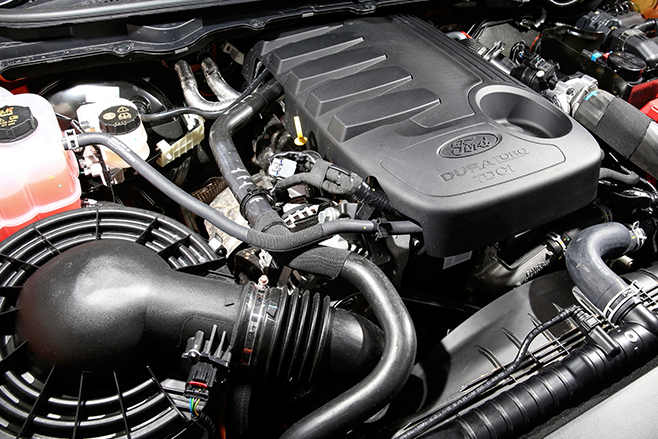
A choice of six-speed manual or auto transmission is offered and, notably, the manual-gear shift behind the five-cylinder engine has been vastly improved by adapting the cable-linked shift mechanism that was previously only used behind the four-cylinder engine.
Regardless of this, buyers shouldn’t expect sports car-like gear shifting. These are light trucks and there’s nothing sporty about them. The Ranger feels more at home on open roads and bush tracks – visibility from behind the wheel is good and the seating position is okay despite there being no reach adjustment on the steering column.
The new electrically-assisted power steering is super light at parking speeds but firms up out on the road, while the suspension soaks up bumps and potholes well.
Ford claims the suspension is the same across the range, however we felt that the Wildtrak has a softer, more compliant and passenger-friendly calibration.
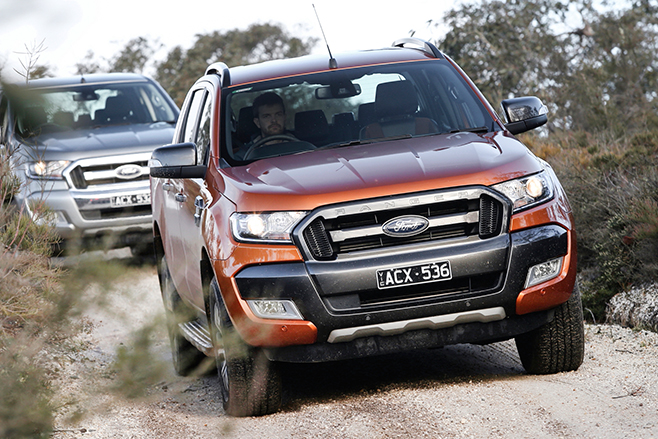
The Wildtrak also benefits from the most sound insulation and, disappointingly, this drops off down the range. We would expect that at least the XLT models would get the top level of insulation for buyers who don’t want the flashy features of the Wildtrak but still expect a high level of refinement for their $60K truck.
The heated and power-adjustable (driver only) leather front seats of the Wildtrak might also be expected in the XLT. The seats, along with the lockable cargo area roller shutter, front parking sensors, reversing camera, improved sound deadening and rear bumper would be useful features on the XLT. They make the extra $4K spend for the Wildtrak tempting, even if the latter’s wild styling isn’t to your taste.
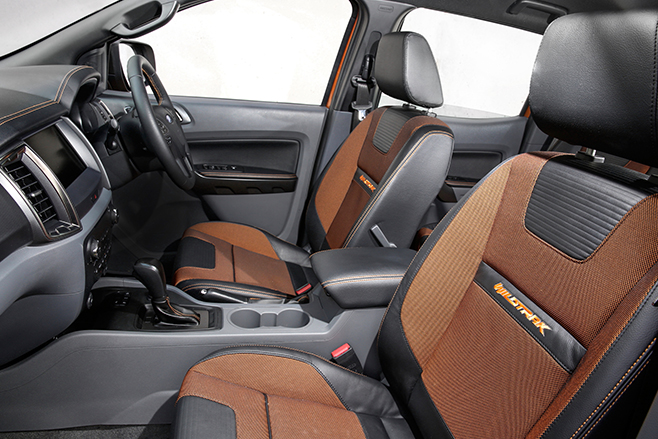
The exterior styling upgrades are limited to the metal forward of the A-pillar, with new guards, bonnet and a more contemporary front fascia.
The interior cops a more comprehensive makeover. The piddly little dash screen of the previous generation has been replaced in the XLT and Wildtrak models with an eight-inch touch screen featuring Ford’s SYNC2 interface.
The XL and XLS variants get a smaller 4.2-inch screen with SYNC1, which is still way better than the old one. XLT and Wildtrak also get a new gauge cluster featuring dual customisable screens either side of the digital speedometer, while the lesser grades feature a more basic dash.
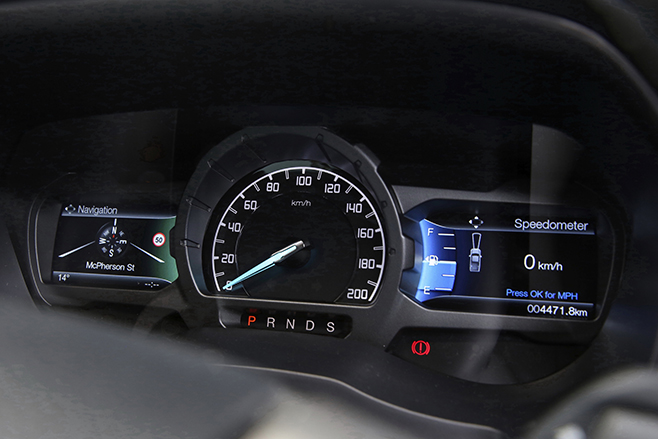
The Ranger 4×4 remains a competent performer off-road with a full complement of electronic driver aids to help its cause. It also has low-range gearing in the transfer case, a lockable rear differential, and adjustable electronic hill descent control all included as standard features. Its 800mm wading depth is another class-leading feature.
With more buyers in the market for utes, and more utes coming to market, this segment will continue to boom through the rest of 2015 and in to 2016. Ford hopes to spearhead the charge with its extensive Ranger line-up.
Ford Ranger Wildtrak PXII
| Engine | 3.2L turbodiesel |
| Max power | 147kW @ 3200rpm |
| Max torque | 470Nm @ 1750rpm |
| Transmission | 6-speed automatic |
| Weight | 2200kg |
| Fuel economy | 9L/100km |
| Price | $60,090 |


